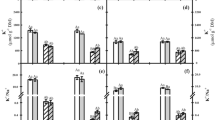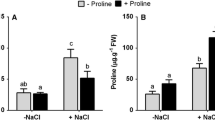Abstract
The effects of proline and/or glycine betaine (GB) application on growth, photosynthetic pigments, H2O2 content, and activities of antioxidant enzymes in rice (Oryza sativa L. cv. KDML105) under salt stress were investigated. The H2O2 content and the activities of superoxide dismutase (SOD), glutathione reductase (GR), and ascorbate peroxidase (APX) but not catalase (CAT) increased under salinity. Under 160 mM NaCl, the CAT activity was maintained on the pre-stress level in the presence of proline, whereas in the presence of GB, the GR activity increased more than without GB application. A co-application of 30 mM proline and 1 mM GB did not reduce the increase in H2O2 caused by the NaCl stress more than applying each of the osmoprotectants and no synergistic effect on the antioxidant enzymes was observed. However, the application of both the osmoprotectants was the most effective in alleviating degradation of photosynthetic pigments.
Similar content being viewed by others
Abbreviations
- APX:
-
ascorbate peroxidase (EC 1.11.1.11)
- CAT:
-
catalase (EC 1.11.1.6)
- GB:
-
glycinebetaine
- GR:
-
glutathione reductase (EC 1.6.4.2)
- GSSG:
-
oxidized glutathione
- H2O2 :
-
hydrogen peroxide
- ROS:
-
reactive oxygen species
- SOD:
-
superoxide dismutase (EC 1.15.1.1)
References
Aebi, H.: Catalase. — In: Bergmeyer, H.U. (ed.): Methods of Enzymatic Analysis, 2nd Ed. Vol. 2. Pp. 673–677. Academic Press, New York — London 1974.
Ali, Q., Ashraf, M., Athar, H.R.: Exogenously applied proline at different growth stages enhances growth of two maize cultivars grown under water deficit conditions. — Pak. J. Bot. 39: 1133–1144, 2007.
Alscher, R.G., Hess, J.L.: Antioxidants in Higher Plants. — CRC Press, Boca Raton 1993.
Anjum, S.A., Farooq, M., Wang, L.C., Xue, L.L., Wang, S.G., Wang, L., Zhang, S., Chen, M.: Gas exchange and chlorophyll synthesis of maize cultivars are enhanced by exogenously-applied glycinebetaine under drought conditions. — Plant Soil Environ. 57: 326–331, 2011.
Apel, K., Hirt, H.: Reactive oxygen species: metabolism, oxidative stress, and signal transduction. — Annu. Rev. Plant Biol. 55: 373–399, 2004.
Arnon, D.I.: Copper enzyemes in isolated chloroplasts. Polyphenol oxidase in Beta vulgaris. — Plant Physiol. 24: 1–15, 1949.
Beadle, C.L.: Growth analysis. — In: Hall, D.O., Bolhár Nordenkampf, H.R., Leegood, R.C. (ed.): Photosysthesis and Production in a Changing Environment: a Field and Laboratory Manual. Pp. 36–46. Chapman & Hall, London 1993.
Bohnert, H.J., Jensen, R.G.: Strategies for engineering water stress tolerance in plants. — Trends Biotechnol. 14: 89–97, 1996.
Bradford, M.M.: A rapid and sensitive method for the qualitation of microgram quantities of protein utilizing the principle of protein-dye binding. — Anal. Biochem. 72: 248–254, 1976.
Cha-Um, S., Kirdmanee, C.: Effect of glycinebetaine on proline, water use and photosynthetic efficiencies and growth of rice seedlings under salt stress. — Turk. J. Agr. Forest. 34: 517–527, 2010.
Cha-Um, S., Samphumphuang, T., Kirdmanee, C.: Glycinebetaine alleviates water deficit stress in indica rice using proline accumulation, photosynthetic efficiencies, growth performances and yield attributes. — Aust. J. Crop Sci. 7: 213–218, 2013.
Chen, T.H.H., Murata, N.: Glycinebetaine: an effective protectant against abiotic stress in plants. — Trends Plant Sci. 13: 499–505, 2008.
Dat, J.F., Foyer, C.H., Scott, I.M.: Changes in salicylic acid and antioxidants during induced thermotolerance in mustard seedlings. — Plant Physiol. 118: 1455–1461, 1998.
Deivanai, S., Xavier, R., Vinod, V., Timalata, K., Lim, O.F.: Role of exogenous proline in ameliorating salt stress at early stage in two rice cultivars. — J. Physiol. Biochem. 7: 157–174, 2011.
Demiral, T., Türkan, I.: Exogenous glycinebetaine affects growth and proline accumulation and retards senescence in two rice cultivars under NaCl stress. — Environ. exp. Bot. 56: 72–79, 2006.
Dhindsa, R.S., Plumb-Dhindsa, P., Thorpe, T.A.: Leaf senescence correlated with increased levels of membrane permeability and lipid peroxidation, and decreased levels of superoxide dismutase and catalase. — J. exp. Bot. 126: 93–101, 1981.
Ehsanpour, A.A., Fatahian, N.: Effects of salt and proline on Medicago sativa callus. — Plant Cell Tissue Organ Cult. 73: 53–56, 2003.
Farooq, M., Basra, S.M.A., Wahid, A., Cheema, Z.A., Cheema, M.A., Khaliq, A.: Physiological role of exogenously applied glycinebetaine in improving drought tolerance of fine grain aromatic rice (Oryza sativa L.). — J. Agron. Crop Sci. 194: 325–333, 2008.
Flowers, T.J., Troke, P.F., Yeo, A.R.: The mechanism of salt tolerance in halophytes. — Annu. Rev. Plant Physiol. 28: 89–121, 1977.
Greenway, H., Munns, R.: Mechanisms of salt tolerance in nonhalophytes. — Annu. Rev. Plant Physiol. 31: 149–190, 1980.
Hasanuzzaman, M., Hossain, M.A., Fujita, M.: Seleniuminduced upregulation of the antioxidant defense and methylglyoxal detoxification system reduces salinityinduced damage in rapeseed seedlings. — Biol. Trace Element Res. 143: 1704–1721, 2011.
Hasegawa, P.M., Bressan, R.A., Zhu, J.K., Bohnert, H.J.: Plant cellular and molecular responses to high salinity. — Annu. Rev. Plant Physiol. Plant mol. Biol. 51: 463–499, 2000.
Hayat, S., Hayat, Q., Alyemeni, M.N., Wani, A.S., Pichtel, J., Ahmad, A.: Role of proline under changing environments. — Plant Signal. Behav. 7: 1456–1466, 2012.
Hernandez, J.A., Alamansa, M.S.: Short-term effects of salt stress on antioxidant systems and leaf water relations of pea leaves. — Physiol. Plant. 115: 251–257, 2002.
Hoque, M.A., Banu, M.N., Okuma, E., Amako, K., Nakamura, Y., Shimoishi, Y., Murata, Y.: Exogenous proline and glycinebetaine increase NaCl-induced ascorbate-glutathione cycle enzyme activities, and proline improves salt tolerance more than glycinebetaine in tobacco Bright Yellow-2 suspension-cultured cells. — J. Plant Physiol. 164: 1457–1468, 2007.
Hoque, M.A., Okuma, E., Banu, N.A., Nakamura, Y., Shimoishi, Y., Murata, Y.: Exogenous proline mitigates the detrimental effects of salt stress more than exogenous betaine by increasing antioxidant enzyme activities. — J. Plant Physiol. 164: 553–561, 2006.
Hossain, M.A., Hasanuzzaman, M., Fujita, M.: Coordinate induction of antioxidant defense and glyoxalase system by exogenous proline and glycinebetaine is correlated with salt tolerance in mung bean. — Front Agr. China 5: 1–14, 2011.
Jana, S., Choudhuri, M.A.: Glycolate metabolism of three submerged aquatic angiosperms during aging. — Aquat. Bot. 12: 345–354, 1981.
Kong-ngern, K., Bunnag, S., Theerakulpisut, P.: Proline, hydrogen peroxide, membrane stability and antioxidant enzyme activity as potential indicators for salt tolerance in rice (Oryza sativa L.) — Int. J. Bot. 8: 54–65, 2012.
Kumar, V., Sharma, R.D.: Effect of exogenous proline on growth and ion content in NaCl stressed and nonstressed cells of mungbean, Vigna radiata var. radiata. — Indian J. exp. Biol. 27: 813–815, 1989.
Lee, H.D., Kim, Y.S., Lee, C.B.: The inductive responses of the antioxidant enzymes by salt stress in the rice (Oryza sativa L.). — J. Plant Physiol. 158: 735–745, 2001.
Li, L., Qu, R., De Koch, A., Fauquet, C.M., Beachy, R.N.: An improved rice transformation method using the biolistic method. — Plant Cell Rep. 12: 250–255, 1993.
Limpinuntana, V.: Physiological aspects of adaptation of rice (Oryza sativa L.) and barley (Hordeum vulgare L.) to low oxygen concentrations in the root environment. — Ph.D. Thesis, Chulalongkorn University, Bangkok 1978.
Ma, Q.Q., Wang, W., Li, Y.H., Li, D.Q., Zou, Q.: Alleviation of photoinhibition in drought-stressed wheat (Triticum aestivum L.) by foliar-applied glycinebetaine. — J. Plant Physiol. 163: 165–175, 2006.
Makela, P., Kontturib, M., Pehua, E., Somersaloa, S.. Photosynthetic response to drought and salt stressed tomato and turnip rape plants to foliar applied glycinebetaine. — Physiol. Plant. 105: 45–50, 2002.
Miller, G., Suzuki, N., Ciftci-Yilmaz, S., Mittler, R. Reactive oxygen species homeostasis and signalling during drought and salinity stresses. — Plant Cell Environ. 33: 453–467, 2010.
Mittova, V., Tal, M., Volokita, M., Guy, M.: Up-regulation of the leaf mitochondria1 and peroxisomal antioxidative systems in response to salt-induced oxidative stress in the wild salt-tolerant tomato species Lycopersicon pennellii. — Plant Cell Environ. 26: 845–856, 2003.
Mohammed, A.R., Tarpley, L. Characterization of rice (Oryza sativa L.) physiological responses to α-tocopherol, glycine betaine or salicylic acid application. — J. agr. Sci. 3: 3–13, 2011.
Nagano, Y., Asada, K.: Hydrogen peroxide is scavenged by ascorbate-specific peroxidase in spinach chloroplasts. — Plant Cell Physiol. 22: 867–880, 1981.
Rahman, S.M., Miyake, H., Takeoka, Y.: Effects of exogenous glycinebetaine on growth and ultrastructure of salt stressed rice seedlings (Oryza sativa L.) — Plant Product. Sci. 5: 33–44, 2002.
Raza, S.H., Athar, H.R., Ashraf, M.: Influence of exogenously applied glycinebetaine on the photosynthetic capacity of two differently adapted wheat cultivars under salt stress. — Pak. J. Bot. 38: 341–351, 2006.
Reddy, M.P., Vora, A.B.: Changes in pigment composition, Hill reaction activity and saccharides metabolism in bajra (Pennisetum typhoides S&H) leaves under NaCl salinity. — Photosynthetica 20: 50–55, 1986.
Rhodes, D., Hanson, A.D.: Quaternary ammonium and tertiary sulfonium compounds in higher plants. — Annu. Rev. Plant Physiol. Plant mol. Biol. 44: 357–384. 1993.
Roy, D., Basu, N., Bhunia, A., Banerjee, S.K.: Counteration of exogenous L-proline with NaCl in salt-sensitive cultivar of rice. — Biol. Plant 35: 69–72, 1993.
Sairam, R.K., Srivastava, G.C., Agarwal, S., Meena, R.C.: Differences in antioxidant activity in response to salinity stress in tolerant and susceptible wheat genotypes. — Biol. Plant 49: 85–91, 2005.
Sekmen, A.H., Türkan, I., Takio, S.: Differential responses of antioxidative enzymes and lipid peroxidation to salt stress in salt-tolerant Plantago maritima and salt-sensitive Plantago media. — Physiol. Plant 131: 399–411, 2007.
Serraj, R., Sinclair, T.R.: Osmolyte accumulation: can it really help increase crop yield under drought conditions? — Plant Cell Environ. 25: 333–341, 2002.
Sharma, P.K., Hall, D.O.: Interaction of salt stress and photoinhibition on photosynthesis in barley and sorghum. — J. Plant Physiol. 138: 614–619, 1991.
Smirnoff, N., Cumbes, Q.J.: Hydroxyl radical scavenging activity of compatible solutes. — Phytochemistry 28: 1057–1060, 1989.
Smith, I.K., Vierheller, T.L., Thorne, C.A.: Assay of glutathione reductase in crude tissue homogenates using 5,5′-dithiobis(2-nitrobenzoic acid). — Anal. Biochem. 175: 408–413, 1988.
Sobahan, M.A., Akter, N., Ohno, M., Okuma, E., Hirai, Y., Mori, I.C., Nakamura, Y, Murata, Y.: Effects of exogenous proline and glycinebetaine on the salt tolerance of rice cultivars. — Biosci. Biotechnol. Biochem. 76: 1568–1570, 2012.
Sobahan, M.A, Arias, C.R., Okuma, E., Shimoishi, Y., Nakamura, Y., Hirai, Y., Mori, I.C., Murata, Y.: Exogenous proline and glycinebetaine suppress apoplastic flow to reduce Na+ uptake in rice seedlings. — Biosci. Biotechnol. Biochem. 73: 2037–2042, 2009.
Wani, S.H., Singh, N.B., Haribhushan, A., Mir, J.I.: Compatible solute engineering in plants for abiotic stress tolerance role of glycine betaine. — Curr. Genomics 14: 157–165, 2013.
Wanchananan, P., Kirdmanee, C., Vutlyano, C.: Effect of salinity on biochemical and physiological characteristics in correlation to selection of salt-tolerance in aromatic rice (Oryza sativa L.). — Sci. Asia 29: 333–339, 2003.
Yancey, P.H., Clark, M.E., Hand, S.C., Bowlus, R.D., Somero, G.N.: Living with water stress: evolution of osmolyte systems. — Science 217: 1214–1222, 1982.
Zhu, J.K.: Salt and drought stress signal transduction in plants. — Annu. Rev. Plant Biol. 53: 247–273, 2002.
Author information
Authors and Affiliations
Corresponding author
Additional information
Acknowledgments: This work was supported by the research group “Special Task Force for Activating Research (STAR): Biochemical and Molecular Mechanisms of Rice in Changing Environments” by the Ratchadaphiseksompot Endowment Fund, Chulalongkorn University and Thailand Research Fund IRG578008. We thank Dr. Supa-art Sirikantaramas for the valuable guidance and Miss Taviporn Kaewneramit for support.
Rights and permissions
About this article
Cite this article
Wutipraditkul, N., Wongwean, P. & Buaboocha, T. Alleviation of salt-induced oxidative stress in rice seedlings by proline and/or glycinebetaine. Biol Plant 59, 547–553 (2015). https://doi.org/10.1007/s10535-015-0523-0
Received:
Revised:
Accepted:
Published:
Issue Date:
DOI: https://doi.org/10.1007/s10535-015-0523-0




